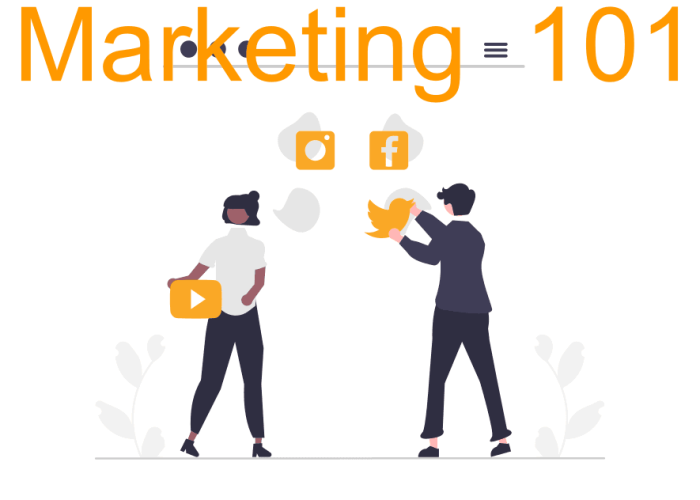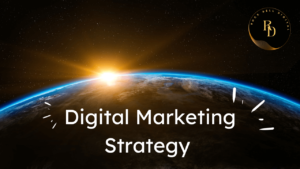Marketing your small business 8 Easy steps to get more business
Marketing your small business is arguable one of the most important parts of a success business. If you do not market no one will know about your business and the services or products you offer. Too many business fail miserably at this. They assume that if they just start a business that customers will naturally just start visiting their business and buying their products. Unfortunately this is not the case. You need to spend time developing a marketing strategy for your business to ensure your success.

Coming up with a marketing plan does not have to be hard, in fact, it can be one of the easiest plans to come up with. The hard part is in the execution of the marketing plan and determining how much money to invest into your marketing.
Table of Contents
Small Business Marketing
Small businesses should prioritize their marketing to maximize their budget and make the most out of their resources. Devising a good strategy can give small businesses the competitive edge over their rivals, helping them to stand out from the crowd. A good strategy should include researching target markets, defining an ideal customer, and creating engaging content. These steps can help small businesses identify potential customers and develop unique ways of connecting with them. Additionally, smartly using social media is vital in today’s competitive marketplace.
A successful strategy requires a deep understanding of the target audience, an engaging message and an attention-grabbing delivery method. Many small businesses have turned to digital platforms and social media to maximize efficiency and cost-effectiveness while optimizing exposure among the right audiences. An comprehensive marketing approach across multiple channels is recommended, as this allows businesses to leverage different platform features in order to create cohesive campaigns that are customized for the individual mediums. Done well, proper small business marketing can lead to tremendous growth opportunities.
Small Business Marketing Strategies
Here are some strategies you can use to market your business and come up with a small business marketing plan.
1. Identify your target market and ideal customer.
Understanding and identifying your target market is essential to any business’s success. Knowing who you are selling to can help ensure that you create products and services tailored to their needs, as well as reaching out with the right message that connects best with them.
By thoroughly understanding your target market, you’ll be able to craft marketing messages that appeal directly to them and develop campaigns for higher conversion rates.
How to identify your target market:
To identify your target market, look at the following factors.
1. Demographic characteristics:
You want to look at some of these demographic characteristics to determine your ideal audience. What is the average age, income level, social status, educational background and others specifics related to your demographic audience?
2. Geographical location:
Where do your ideal customers live or work? Are they in one specific local area, or are they spread out over a broad geographical region?
3. Needs and interests.
You want to determine the needs and interests of your ideal customers. What are their pain points, and how does your product or service help solve that?
4. Buying habits:
What are your customer’s buying habits? Do they prefer to shop in person or online? You also want to know how how much research they do before they purchase your product or is an impulse buy.
2. Use social media
In today’s digital age, social media is a powerful tool to use when marketing to customers. Strategically leveraging platforms such as Instagram, YouTube and Twitter can help capture customer’s attention, increase brand awareness and drive sales.
Here are some ways you can use social media to get more customers:
- Start by researching the demographics of users who use each channel – this information can be used to target the right audience for your brand or product.
- Take advantage of existing trends in order to spread content quickly.
- Creating a branded hashtag is important in order to further engage with customers long term as well as cultivate customer loyalty.
- Set up social media accounts on the platforms that your ideal customer is likely to visit.
- Develop a content strategy that aligns with your business goal and connects with your ideal customer.
- Engage your audience using the social media tools that are available to you.
3. Create a website:
Building a website is an essential part of a business’s success in the digital age. A website is an online hub for customers to access information, buy products, and interact with the business. Having a well-constructed website provides credibility to your business while also adding another noteworthy touchpoint between the company and the customer. Potential customers are more likely to trust companies whose online presence is well maintained, so it is important to invest time and money into constructing a visually appealing and functional website.
How to build a website for marketing your small business:
1. Determine your goals:
What is the overall goal of your website? Do you want to drive traffic to your physical store, generate leads or sell products online? Understanding what you want your website to achieve will help you create a website that will best fit into your overall marketing plan.
2. Choose a domain name:
Select a domain name that is easy to remember and type in. It is a best practice to use your branded business name in your website domain name.
3. Choose a website builder
There are many website builders available to you, but it is going to come down to the overall goal of your website. If you want to sell products, Shopify online is a good option, and if it is going to be for content marketing, it is hard to go wrong with WordPress.
4. Design your website:
Using premade templates and design is the easiest way to get your website up and running quickly. You can also use freelancers like on Fiverr or Upwork to outsource it quickly.
5. Add Content
Make sure you add content to your website that is relevant to your target audience. This can include information posts or valuable information in a pdf checklist form.
6. Optimize for search engines.
To be found by your potential customers, you must ensure your website is optimized for search engines. You can add relevant keywords and headings and to create high-quality content that resonates with your audience.
4. Use email marketing
Email marketing can be an effective way to get your message out to a wide audience. It can build relationships with customers, establish credibility and trust, and even motivate users to take action.
To begin, you will want to create a targeted list of contacts based on demographic information and interests that you have collected. You will also need to craft a good subject line for your email because this is the first thing that people see in their inboxes. Make sure it is attention-grabbing and concise so your reader is compelled to open it.
Once the subject line has been established, the body of the email should explain what you are promoting clearly and succinctly. Be sure to include relevant business information such as location or website address as well as easy-to-find contact information at the end of the email. Utilizing these simple steps will help you successfully use email as an effective marketing tool!
5. Use paid advertising
Paid advertising is a great way to get your product or service seen by a large number of potential customers. With so many people now using the Internet and social media, it’s never been easier to place strategically targeted ads that will be seen by the right people.
When setting up a paid advertisement campaign, it’s important to always test different versions – such as variations of visuals and text – in order to determine which is most effective.
Additionally, make sure you’re taking into account location, demographics, and behaviors when curating your campaigns for the greatest chance of success.
Finally, consider using online advertising experts or professionals who specialize in this field for even better results.
6. Collaborate with other businesses
Collaborating with another business can give your strategies and activities a major boost in effectiveness. To get the most out of this, you need to carefully research the other business to ensure that your values are aligned and that you both have similar goals. It’s also essential to establish a timeline with milestones so both companies know what is expected from them and when it’s due. Communication is key: ensure everyone has access to the same information and understands their roles in developing and running successful campaigns.
1. How to collaborate with other businesses?
Here are some ways you can collaborate with other businesses:
2. Identify potential partners:
Look for companies that complement your products or services and have a similar target audience. These businesses may be interested in collaborating with you on marketing efforts.
3. Develop a proposal:
Once you have identified potential partners, develop a proposal outlining the benefits of collaborating with your business and how the collaboration will benefit both parties.
4. Negotiate terms:
Work with the other business to negotiate terms for the collaboration, such as how the collaboration will be promoted, who will be responsible for what tasks, and any financial arrangements.
5. Implement the collaboration:
Once the terms have been agreed upon, work with the other business to implement the collaboration. This might involve co-hosting an event, cross-promoting each other’s products or services, or collaborating on a joint marketing campaign.
6. Evaluate the results:
After the collaboration has been completed, evaluate the results to see how it performed and identify any areas for improvement.
7. Participate in local events
Participating in local events is an excellent way to promote your business. It allows you to network with potential customers and other businesses in the area, as well as showcase your products and services.
Before signing up for any event, be sure to research its purpose and mission. This can help you target the appropriate audience and determine if it’s a worthwhile venture for you.
Once you’ve found the right opportunity, don’t be afraid to take initiative; contact the organizers with questions or even introduce yourself to people who might be attending.
Being involved locally should always be approached positively, so make sure that everyone you interact with remembers you in a good light!
8. Offer promotions.
Offering promotions to promote your business can be an effective strategy to draw in more customers, brand loyalty, and ultimately more profits. However, it is important to ensure that you are offering the right type of promotion for the right type of customer. Offering promotional discounts may be appealing to some buyers, but offering exclusive access or early viewing of products may be more attractive to others. Additionally, tracking the success of your promotions is essential. Having up-to-date analytics at your disposal will enable you to measure what works (and doesn’t) for each individual customer segment so you know where best to target them with future marketing efforts. Remember — thoughtful promotion strategies are key components in successful business growth!
How to advertise your small business locally
Advertising your small business locally can be an excellent way of getting the word out about your company and increasing its success. A successful campaign starts with a clear understanding of who you are targeting, what products and services your business offers, and how you will cost-effectively reach those people. To connect with your target audience, consider including local elements in your advertising copy to create a solid emotional connection. Additionally, leveraging local media, such as radio or television ads, can help you gain traction that furthers your goals. Last but not least, always make sure to track the progress of any campaigns or promotional efforts to determine where you should dedicate additional resources to maximize success in the long term.
Here are some strategies you can use to market locally.
1. Local directories:
Add your business to local directories, such as Google My Business and Yelp, to make it easier for people in your area to find your business.
2. Local advertising:
Consider using local advertising platforms, such as local newspapers, radio stations, or billboards, to reach people in your area.
3. Participate in local events:
Participating in local events, such as trade shows or community festivals, can help you reach new customers and build relationships with your community.
4. Social media:
Social media platforms like Facebook and Instagram allow you to target your ads to specific locations. Use social media advertising to reach people in your area.
5. Referral marketing:
Encourage your customers to refer your business to their friends and family by offering incentives, such as discounts or free products.
6. Partner with other local businesses:
Partnering with other local businesses, such as through joint or cross-promotions, can help you reach new customers and expand your reach.
Tips to promote your small business with no money
It is possible to promote a small business with no money by using free or low-cost marketing strategies. Here are some ideas you can consider:
Use social media: Social media platforms, such as Facebook, Instagram, and Twitter, are free to use and can be effective tools for reaching your target market. Use social media to share updates about your business, engage with customers, and promote your products or services.
Use email marketing: Email marketing allows you to send targeted messages to your customers and prospects. Use email marketing to promote your products or services, share updates about your business, and offer special deals or discounts.
Participate in local events: Participating in local events, such as trade shows or community festivals, can help you reach new customers and build relationships with your community. Many local events have no or low fees for participation.
Use referral marketing: Encourage your customers to refer your business to their friends and family by offering incentives, such as discounts or free products.
Collaborate with other businesses: Partnering with other businesses, such as through joint promotions or cross-promotions, can help you reach new customers and expand your reach.
Use content marketing: Create valuable, informative content, such as blog posts or videos, and share it through your website and social media channels. This can help attract traffic to your website and establish your business as an authority in your industry.
By using these strategies, you can effectively promote your small business with little or no budget. It may take more time and effort to implement these strategies, but they can be an effective way to reach new customers and grow your business.
Related articles

What Is Digital Marketing, and Why Is It Important for My Business?
In the digital age, where consumers spend a significant portion of their lives online, understanding what digital marketing is and why it’s crucial for your

Understanding Lead Generation on Facebook
In today’s digital marketing landscape, generating leads is more critical than ever for businesses aiming to grow their customer base and boost revenue. Among the

The Ultimate Guide to Networking and building relationships with customers: Tips and strategies to grow your business.
The Ultimate Guide to Networking and building relationships with customers: Tips and strategies to grow your business and build with relationship networking. Networking and Building









